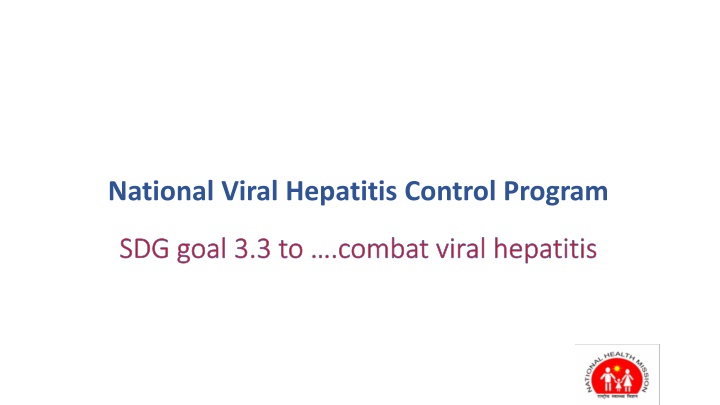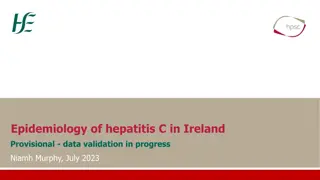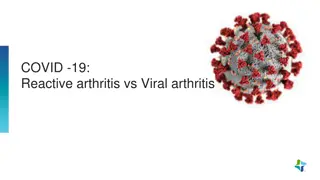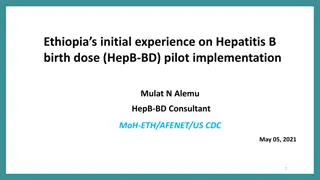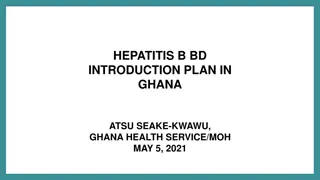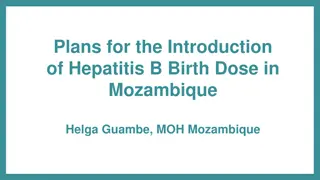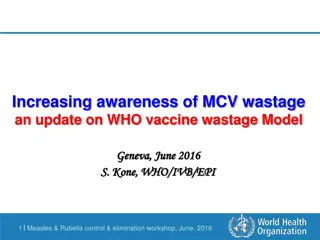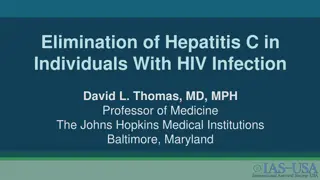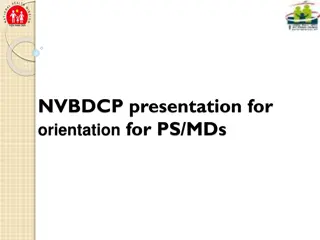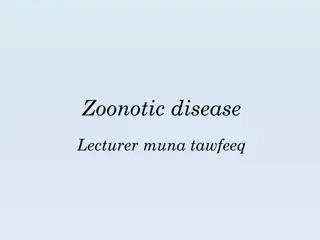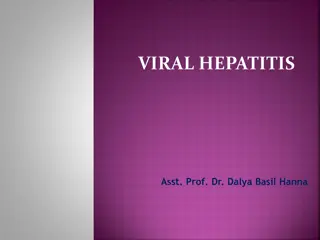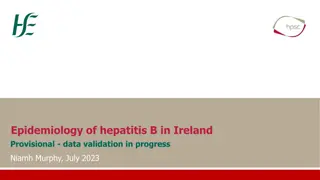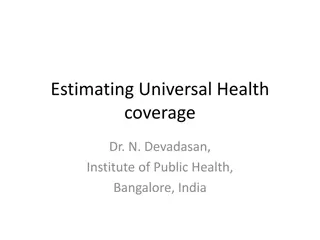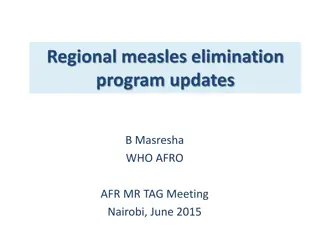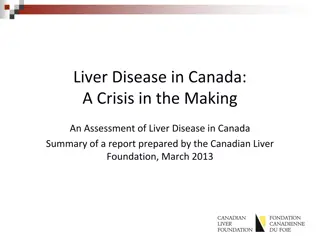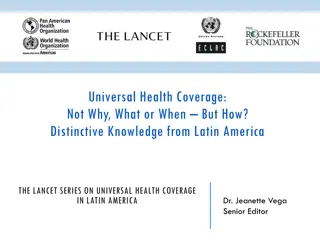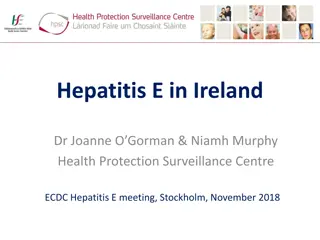National Viral Hepatitis Control Program - Achieving Universal Health Coverage and Elimination Goals
The National Viral Hepatitis Control Program in India is working towards combating viral hepatitis and achieving SDG goal 3.3 through a comprehensive approach that includes awareness generation, prevention, management, and financing under the NHM. The aim is to eliminate hepatitis C by 2030, reduce the infected population, morbidity, and mortality associated with hepatitis B and C, as well as decrease the risk and impact of hepatitis A and E. Key objectives focus on enhancing community awareness, early diagnosis, strengthening healthcare infrastructure, building capacities, and developing linkages with existing programs to effectively manage viral hepatitis.
Download Presentation

Please find below an Image/Link to download the presentation.
The content on the website is provided AS IS for your information and personal use only. It may not be sold, licensed, or shared on other websites without obtaining consent from the author.If you encounter any issues during the download, it is possible that the publisher has removed the file from their server.
You are allowed to download the files provided on this website for personal or commercial use, subject to the condition that they are used lawfully. All files are the property of their respective owners.
The content on the website is provided AS IS for your information and personal use only. It may not be sold, licensed, or shared on other websites without obtaining consent from the author.
E N D
Presentation Transcript
National Viral Hepatitis Control Program SDG goal 3.3 to .combat viral hepatitis
Universal Health Coverage Umbrella for Viral Hepatitis- India s response Swachh Bharat Awareness generation MCH Immunization NVHCP Prevention Management NACP ( All 5 viruses) HCW Injection Safety Diagnosis Surveillance Across all geographies, all people ( focus on priority groups), finances under NHM ( domestic budget), Linkages to other programs and schemes ( NCD, Ayushman Bharat)
Ensuring Universal Health Coverage Ensuring Access Addressing Quality Ensuring Financing All states and UTs Identifying key Population- for different viruses Addressing priority populations Identifying appropriate intervention Training and capacity building Data quality Quality services Quality commodities Integrated approach Avoiding duplication Domestic funding for sustainability
Aims Elimination of Hepatitis C by 2030 Reduction in the infected population, morbidity and mortality associated with Hepatitis B and C Reduce the risk, morbidity and mortality due to Hepatitis A and E.
Key Objectives Enhance community awareness on hepatitis and lay stress on preventive measures Provide early diagnosis and management of viral hepatitis at all levels of healthcare Develop capacities for implementation of standard diagnostic and treatment protocols
Key Objectives Strengthen the existing infrastructure facilities build capacities of existing human resource raise additional human resources, only where required Develop linkages with the existing programs/ ministerial activities NACP, Immunisation, MH, Mo Drinking water and Sanitation Develop a web-based Viral Hepatitis Information and Management System to maintain a registry of persons affected with viral hepatitis and its sequelae.
Overall Framework- Snapshot - Guideline and Policy Formulation M & E, Surveillance, Research Central Procurement Coordination - - - NPMU Annual PIP and targets, State level planning & scaleup, intersectoral coordination, M & E SPMU Labs and Treatment sites Diagnosis, Treatment, Referral, Quality Control Key Documents: National Action Plan- costed; Operational plan for roll out of NVHCP; National Laboratory Guidelines for Testing of Viral Hepatitis; National Guidelines for Diagnosis and management of Viral hepatitis; Technical Guidelines for management of hepatitis B; National M & E framework and the electronic MIS
Key interventions-Prevention Awareness generation & Behavior Change Communication Immunization for hepatitis B birth dose, high risk groups, health care workers Provision of safe blood and blood products Injection Safety by Use of RUP/AD syringes in all government HCFs Safe socio-cultural practices
Key interventions-Diagnosis & Treatment Screening - serological tests Confirmation - molecular tests (where required) Treatment of uncomplicated cases - at treatment centres, drug dispensation up to HWC Treatment of complicated cases at model treatment centres Referral and linkages Capacity building and quality assurance
Model for Treatment Model Treatment centers for Treatment of Hepatitis B & C for complicated cases & management of other hepatitis; Medical colleges and Tertiary centers Phased scale up District Hospitals / Secondary care Treatment centers for Treatment of Hepatitis B & C; Refer complicated cases to Model Treatment Centers Sub District level Dispensation
Key Enablers for NVHCP Inter-sectoral coordination Harnessing Existing Capacities Central Procurement for Economies of Scale Community Involvement Technical Working Groups Supply Chain Management Online M & E System Sustained Domestic Funding
Operationalizing the plan for testing and Operationalizing the plan for testing and Treatment: the stepwise approach Treatment: the stepwise approach The Process Advocacy on World Hepatitis Day and other forums Constitution of state steering committees Inclusion of Viral hepatitis in State annual plans- integrated approach Training of master trainers- over 435 across the country Development of on line recording and reporting system Procurement of test kits and distribution in the vast country Inputs Development of the National Action Plan- the guiding document Financing the plan: 100% domestic budget, integrated planning Constitution of Technical Resource Groups: Policy and guidelines development Development of standard training manuals Laboratory guidelines Clinical Management guidelines
Operationalizing the plan for testing and Operationalizing the plan for testing and Treatment: the stepwise approach Treatment: the stepwise approach Outcomes / Progress till date 95 centers functional in 22 states 20,000 approx. patients started treatment in short duration (Sept 2018 to Sept 2019) Consolidated the smaller projects and state programs under the National program for harmonization Introduction of Hepatitis B testing for pregnant women Guidance on vaccination for health care workers at risk Guidance to shift towards RUP in government sector in a phased manner Targeted testing started: vulnerable population groups prioritized
Status update of State/UT Status update of State/UT
National Viral Hepatitis Control Program Issue Action required Establishment of State Viral Hepatitis Management Unit Established : 31 States/UTs Pending in MP, A&N Islands, Chandigarh, D&NH and Daman & Diu Established : 25 States/UTs State Steering Committee Pending in Goa, MP, Mizoram, Uttarakhand & all UTs MTCs Established in 22 States/UTs 24 functional Pending in: AndhraPradesh,Chhattisgarh,Karnataka,Kerala,MP,Meghalaya,Mizor am,Odisha, Puducherry, UP, Uttarakhand, A&N, Chandigarh, Assam Model Treatment Centre/Treatment Centre TCs functional in 95 districts (Completed in Punjab, Haryana, J&K ,Gujarat)
National Viral Hepatitis Control Program Activities Status Medical Officers Training Completed: 18 States Training Progress Lab Tech Training Completed: 15 states Training Completed: 10 states Bihar, Goa & Sikkim have done only for M&E M& E Portal Completed in Himachal & Maharashtra Immunization of Health Workers Started in Gujarat, Mizoram, Tamil Nadu & Telangana, Haryana
